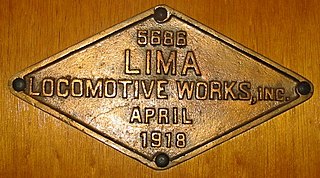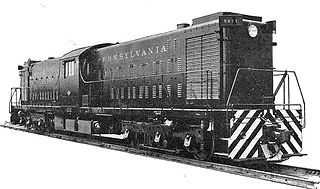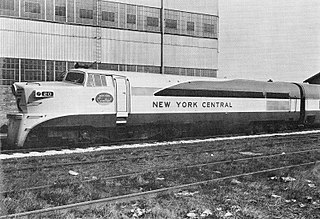The Pennsylvania Railroad, legal name The Pennsylvania Railroad Company, also known as the "Pennsy", was an American Class I railroad that was established in 1846 and headquartered in Philadelphia, Pennsylvania. At its peak in 1882, the Pennsylvania Railroad was the largest railroad, the largest transportation enterprise, and the largest corporation in the world, on par with the London & North Western Railway.

A diesel locomotive is a type of railway locomotive in which the power source is a diesel engine. Several types of diesel locomotives have been developed, differing mainly in the means by which mechanical power is conveyed to the driving wheels. The most common are diesel–electric locomotives and diesel–hydraulic.

The Baldwin Locomotive Works (BLW) was an American manufacturer of railway locomotives from 1825 to 1951. Originally located in Philadelphia, Pennsylvania, it moved to nearby Eddystone in the early 20th century. The company was for decades the world's largest producer of steam locomotives, but struggled to compete when demand switched to diesel locomotives. Baldwin produced the last of its 70,000-plus locomotives in 1951, before merging with the Lima-Hamilton Corporation on September 11, 1951, to form the Baldwin-Lima-Hamilton Corporation.

Lima Locomotive Works (LLW) was an American firm that manufactured railroad locomotives from the 1870s through the 1950s. The company's name is derived from the location of its main manufacturing plant in Lima, Ohio. The shops were located between the Erie Railroad main line, the Baltimore & Ohio's Cincinnati-Toledo main line and the Nickel Plate Road main line and shops.

Locomotive classification on the Pennsylvania Railroad took several forms. Early on, steam locomotives were given single-letter classes. As the 26 letters were quickly assigned, that scheme was abandoned for a more complex system. This was used for all of the PRR's steam locomotives, and — with the exception of the final type bought — all electric locomotives also used this scheme.

The Grand Trunk Western Railroad Company was an American subsidiary of the Grand Trunk Railway, later of the Canadian National Railway operating in Michigan, Illinois, Indiana, and Ohio. Since a corporate restructuring in 1971, the railroad has been under CN's subsidiary holding company, the Grand Trunk Corporation. Grand Trunk Western's routes are part of CN's Michigan Division. Its primary mainline between Chicago and Port Huron, Michigan serves as a connection between railroad interchanges in Chicago and rail lines in eastern Canada and the Northeastern United States. The railroad's extensive trackage in Detroit and across southern Michigan has made it an essential link for the automotive industry as a hauler of parts and automobiles from manufacturing plants.

The EMD F7 is a model of 1,500-horsepower (1,100 kW) diesel-electric locomotive produced between February 1949 and December 1953 by the Electro-Motive Division of General Motors (EMD) and General Motors Diesel (GMD).

A rail yard, railway yard, railroad yard (US) or simply yard, is a series of tracks in a rail network for storing, sorting, or loading and unloading rail vehicles and locomotives. Yards have many tracks in parallel for keeping rolling stock or unused locomotives stored off the main line, so that they do not obstruct the flow of traffic. Cars or wagons are moved around by specially designed yard switcher locomotives (US) or shunter locomotives (UK), a type of locomotive. Cars or wagons in a yard may be sorted by numerous categories, including railway company, loaded or unloaded, destination, car type, or whether they need repairs. Yards are normally built where there is a need to store rail vehicles while they are not being loaded or unloaded, or are waiting to be assembled into trains. Large yards may have a tower to control operations.

The Consolidation Line was a series of diesel-electric railway locomotive designs produced by Fairbanks-Morse and its Canadian licensee, the Canadian Locomotive Company. Railfans have dubbed these locomotives C-liners, however F-M referred to the models collectively as the C-Line. A combined total of 165 units were produced by F-M and the CLC between 1950 and 1955.

Electro-Motive Diesel is a brand of diesel-electric locomotives, locomotive products and diesel engines for the rail industry. Formerly a division of General Motors, EMD has been owned by Progress Rail since 2010. Electro-Motive Diesel traces its roots to the Electro-Motive Engineering Corporation, founded in 1922 and purchased by General Motors in 1930. After purchase by GM, the company was known as GM's Electro-Motive Division. In 2005, GM sold EMD to Greenbriar Equity Group and Berkshire Partners, and in 2010, EMD was sold to Progress Rail, a subsidiary of the heavy equipment manufacturer Caterpillar. Upon the 2005 sale, the company was renamed to Electro-Motive Diesel.

The EMD GP7 is a four-axle (B-B) diesel-electric locomotive built by General Motors Electro-Motive Division and General Motors Diesel between October 1949 and May 1954.

In railroading, a slug is a version of a diesel–electric locomotive which lacks a prime mover and often a cab. It derives the electrical power needed to operate its traction motors and motor controls from a fully-powered mother locomotive. At low speeds the drawing force a diesel–electric locomotive can produce is often limited by its traction motors or the grip of its drive wheels on the track, not the capability of its diesel engine(s). A slug adds more traction motors and drive wheels to both use more of the power the mother's engine can produce that cannot otherwise be used at low speeds and provide better braking, without the expense of a full locomotive.

In rail transport, a cow–calf is a set of diesel switcher locomotives. The set is usually a pair, though a few three-unit sets were built. A cow is equipped with a cab, and a calf is not. The two are coupled together and equipped with multiple unit train control so that both locomotives can be operated from the single cab.

The Baldwin VO-1000 is a diesel-electric switcher locomotive built by the Baldwin Locomotive Works between January 1939 and December 1946. These units were powered by a naturally aspirated eight-cylinder diesel engine rated at 1,000 horsepower (746 kW), and rode on a pair of two-axle trucks in a B-B wheel arrangement. These were either the AAR Type-A switcher trucks, or the Batz truck originally developed by the Atchison, Topeka and Santa Fe Railway as a leading truck for steam locomotives. 548 examples of this model were built for American railroads, including examples for the Army and Navy.

Baldwin Locomotive Works produced several different Baldwin DR-6 models of 6-axle passenger train-hauling diesel locomotives between 1945 and 1948. The series comprised eight individual versions, all of which sold only in small numbers; across all versions, only 39 locomotives were produced. Each version was produced only for a single railroad. Many shared the same Baldwin model number, DR-6-4-2000, even though they were rather different; this was because the Baldwin model only encoded the total axles (6), the driven axles (4) and the power output. The single exception was the single unit produced for the Chicago and North Western Railway, which had a single 1,000 hp (750 kW) engine and was model number DR-6-2-1000. In the AAR wheel arrangement scheme of classification, these locomotives were of A1A-A1A and A1A-3 arrangements, respectively.

Union Railroad is a Class III switching railroad located in Allegheny County in Western Pennsylvania. The company is owned by Transtar, Inc., which is a subsidiary of Fortress Transportation and Infrastructure Investors, after being acquired from U.S. Steel in 2021. The railroad's primary customers are the three plants of the USS Mon Valley Works, the USS Edgar Thomson Steel Works, the USS Irvin Plant and the USS Clairton Coke Works.

The Baldwin DT-6-6-2000 was a twin-engined diesel-electric transfer switcher, built by Baldwin Locomotive Works between 1946 and 1950.

The A-3177 (LT-2500) was a diesel-electric transfer-unit locomotive, built by the Lima-Hamilton Corporation between 1950 and 1951. The A-3177 was the final locomotive model produced by Lima-Hamilton before the company merged with the Baldwin Locomotive Works in September 1951 to form the Baldwin-Lima-Hamilton Corporation (BLH).
The BLH RT-624 was a twin-engined diesel-electric locomotive, built by Baldwin-Lima-Hamilton Corporation between August 1951 and February 1954.

The RP-210 was a streamlined 1,000 hp (750 kW) locomotive built in 1956 by Baldwin-Lima-Hamilton, specifically to operate with the experimental, all-aluminum Train-X coaches that were built by the Pullman-Standard Car Manufacturing Company. The model represented Baldwin's attempted entry into the lightweight passenger locomotive market, but only three of the low-slung diesel-hydraulic units were produced. The first RP-210 was built for the New York Central Railroad to power their Ohio Xplorer train between Cleveland, Columbus, and Cincinnati, and a pair was purchased by the New York, New Haven and Hartford Railroad to double-end their Dan'l Webster, running between New York City and Boston.


















